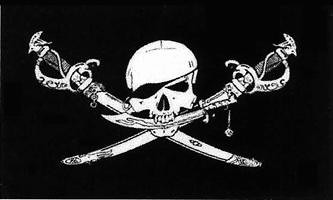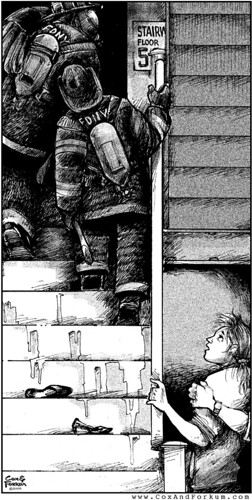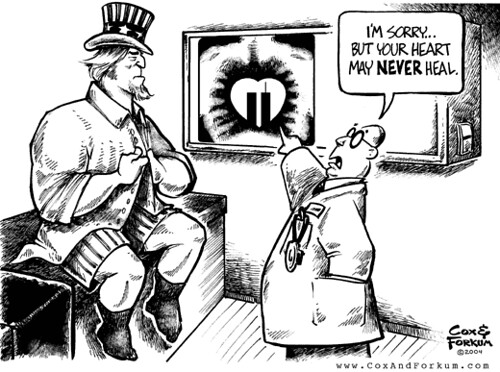Ghost Plan for a Ghost Town
Ghastly oversight in New Orleans.
By Chris Regan & Bryan Preston
Until it became known as the city of looters threatening jihad against Red Cross rescue workers, New Orleans, Louisiana was known as a city of ghosts. A walk through its French Quarter made clear why. Stately homes dating back to the city's founding look out on streets that have seen war, flood, storm, and pestilence over the centuries. Those floods used to literally raise the dead: The water table is so shallow in the Mississippi delta that even a slight rain would make buried coffins float. City residents eventually tired of seeing Uncle Etienne, dead ten years, riding the rapids down Canal Street after the latest spring shower, so they started placing all of their dead in above-ground mausoleums. But the ghosts, it was said, still stalked the streets, haunting the city whose spongy ground and seasonal storms had disturbed their eternal rest.
After hurricane Katrina, thousands of new ghosts will take up the march. Their lives, history will record, were taken not so much by yet another natural disaster, but by a human-made disaster of epic scale. If you go looking for these ghosts, any New Orleans bus lot will be a good place to start.
The Lesson of Georges
The story of buses has become the seminal tale of dereliction in New Orleans. Though the city owned hundreds of buses, it failed to use them to move its most vulnerable citizens — vulnerable either because of poverty or physical infirmity — out of the bowl-shaped city to safe higher ground. Initially it seemed as if the city that knew the levees protecting it would one day break just didn't have a plan to move so many people to safety. But it turns out that emergency-preparedness officials in New Orleans did have a plan, and they did think to use buses to evacuate the city before a major hurricane. They just decided not to fully implement it as Plan A. The plan was developed as a hurricane Georges lesson learned. This appeared in an article that appeared in November 2004 in the Natural Hazards Observer: Residents who did not have personal transportation were unable to evacuate even if they wanted to. Approximately 120,000 residents (51,000 housing units x 2.4 persons/unit) do not have cars. A proposal made after the evacuation for Hurricane Georges to use public transit buses to assist in their evacuation out of the city was not implemented for Ivan. If Ivan had struck New Orleans directly it is estimated that 40-60,000 residents of the area would have perished.
So the question after dodging the Georges bullet seemed to be, "Do we figure out a way to use buses or do we allow 50,000 people to die for the crime of not having a car?" They chose Plan B.
Hurricanes come in cycles of frequency and activity. Meteorologists don't really know why, other than that it might have something to do with solar activity and shifting deep sea currents (but responsible scientists do know the hurricane cycle has nothing to do with humans burning fossil fuels). We are currently at the cusp of an intensification of hurricanes. We can expect more of them, and we can expect more of them to be strong.
As the hurricane cycle kept building in the last decade or so, there were increasing calls to create a real evacuation plan. Many of those who pleaded for the use of buses will come forward soon, but for everyone who does, there are others who do not have the strength to come forward. They can't hack their way out of their attics right now to tell us their side of it. And the journalists at the New Orleans Times-Picayune are no longer interested in speaking on their behalf. As their "Open Letter to the President" shows, they're now the spokesmen for other political interests. It didn't used to be that way until the inevitable happened. Now they have circled the wagons to protect the guilty and accuse the innocent.
Each hurricane season Louisiana officials decided to play a game of Russian roulette with those lives. They knew disaster would eventually strike, but gambled that it would happen on someone else's watch. They did take the action that nervous officials typically take: They formed a working group to reassure themselves and look busy to everyone else. According to that Natural Hazards Observer article from November 2004, here's what the hard-charging working group came up with:
Unwilling to merely accept this reality, emergency managers and representatives of nongovernmental disaster organizations, local universities, and faith based organizations have formed a working group to engage additional faith-based organizations in developing ride-sharing programs between congregation members with cars and those without. In the wake of Ivan’s near miss, this faith-based initiative has become a catalyst in the movement to make evacuation assistance for marginalized groups (those without means of evacuation) a top priority for all levels of government.
So a working group decided that the workable solution to the problem of thousands of stranded citizens was to ask churches to set up a giant car-pool system. The plan further called for a DVD to get the word out, which was still in production when Katrina struck. A cynic might say that such a plan was drafted so city officials could say they had a real evacuation plan, written down on official letterhead and signed and announced and all of the other things that make bureaucrats swoon, but was in point of fact yet another exercise in passing the buck to the next schmuck to occupy the conference-table chair. If it was a real plan, it doesn't seem a stretch to say that as hurricane Katrina bore down on the Big Easy, the real plan really failed.
More hurricane lessons from Georges and actions for Ivan, from the Natural Hazards Observer:
To aid in the evacuation, transportation officials instituted contraflow evacuation for the first time in the area’s history whereby both lanes of a 12-mile stretch of Interstate 10 were used to facilitate the significantly increased outbound flow of traffic toward the northwest and Baton Rouge. The distance of the contraflow was limited due to state police concerns about the need for staff to close the exits. And, although officials were initially pleased with the results, evacuees felt the short distance merely shifted the location of the major jams.
You read it right: "for the first time in the area's history."
So not only did officials keep putting bus-utilization plans on hold, they only began using an ineffectively implemented contraflow system last year. The contraflow plan was to turn both sides of the highways into outgoing lanes, but all that did was move traffic tie-ups from nearer the city to the points where the contraflow was ended. And they couldn't make the entire highways contraflow for miles and miles because some lanes were needed to get things into the city (rescuers, etc.). City officials barely even scratched the surface of what could have been possible in competently evacuating that city using an early-warning system, buses, and contraflow.
Third Time's a Disaster
The result was that in the worst-case scenario. The Natural Hazards Observer again: Regional and national rescue resources would have to respond as rapidly as possible and would require augmentation by local private vessels (assuming some survived). And, even with this help, federal and state governments have estimated that it would take 10 days to rescue all those stranded within the city. No shelters within the city would be free of risk from rising water. Because of this threat, the American Red Cross will not open shelters in New Orleans during hurricanes greater than category 2; staffing them would put employees and volunteers at risk. For Ivan, only the Superdome was made available as a refuge of last resort for the medically challenged and the homeless.
It was to take ten days for rescue to get everyone out, not counting the dead. And city and state officials knew it would take ten days. For them to cry in the current crisis that 72 hours is unacceptable rings more than a little hollow.
Now we see belatedly that there never was a reasonable local evacuation plan or shelters with a hope of withstanding a real hurricane. And the communication process before the storm was as atrocious as the plan itself. It was no different for hurricane Ivan:
As Ivan charged through the Gulf of Mexico, more than a million people were urged to flee. Forecasters warned that a direct hit on the city could send torrents of Mississippi River backwash over the city's levees, creating a 20-foot-deep cesspool of human and industrial waste. Residents with cars took to the highways. Others wondered what to do.
In this case, city officials first said they would provide no shelter, then agreed that the state-owned Louisiana Superdome would open to those with special medical needs. Only Wednesday afternoon, with Ivan just hours away, did the city open the 20-story-high domed stadium to the public. Mayor Ray Nagin's spokeswoman, Tanzie Jones, insisted that there was no reluctance at City Hall to open the Superdome, but said the evacuation was the top priority.
"Our main focus is to get the people out of the city," she said.
Callers to talk radio complained about the late decision to open up the dome, but the mayor said he would do nothing different.
"We did the compassionate thing by opening the shelter," Nagin said. "We wanted to make sure we didn't have a repeat performance of what happened before. We didn't want to see people cooped up in the Superdome for days."
When another dangerous hurricane, Georges, appeared headed for the city in 1998, the Superdome was opened as a shelter and an estimated 14,000 people poured in. But there were problems, including theft and vandalism.
Katrina was a three-peat major hurricane failure in planning. City and state officialdom didn't do enough after Georges warned them, kept hoping against hope when Ivan spared them, and have now reaped the mighty whirlwind of Katrina. When compassion is defined as delay and the subject is hurricanes, you are asking for a serious catastrophe. President Bush's call during the height of Katrina interrupted that compassionate liberalism. The goal of the locals was to avoid a mandatory evacuation that would cause trouble by having too many people in the shelter of last resort with too little security and no food or water. The goal was to fool more people to stay home or leave so that the city didn't look bad or descend into violent chaos if it took a direct hit. The mayor knew the danger of mass chaos with too many stuck in the Dome and planned for none of it.
Now we know that had Katrina held its strength and course at Cat 5+ it would have probably ripped most of the roof right off the Superdome. And the roof in that design is what holds the walls up. That was the other part of the scam. Nobody really knows if the Dome could take over 130MPH sustained, though they claimed a 200MPH design.
So the Louisiana state governor and emergency-preparedness officials allowed them to get by all these years with a sham plan that doesn't appear to even meet state standards. And guess what? Oh yeah, the state didn't even measure up to the federal requirements either:
Other federal and state officials pointed to Louisiana's failure to measure up to national disaster response standards, noting that the federal plan advises state and local emergency managers not to expect federal aid for 72 to 96 hours, and base their own preparedness efforts on the need to be self-sufficient for at least that period. "Fundamentally the first breakdown occurred at the local level," said one state official who works with FEMA. 'Did the city have the situational awareness of what was going on within its borders? The answer was no."
This is why every city must have sharp leadership, and a disciplined, non-corrupt police force that won't melt away into the population when under attack, like Saddam's army. And every state must have a governor who, when under pressure to perform, will not freeze and cry before consulting with lawyers and advisers before freezing up again in a passive-aggressive way that shifts blame to those trying to help. That's what we're all supposed to get in exchange for the big salaries, fancy dinners, 24-hour security, and other perks that go with the powerful political jobs. We give our politicians quite a lot. Is it too much to ask them to prepare for disasters in ways that won't get us all killed?
New Orleans is a major port of entry and exit for commerce. It's sinking into a bowl and is threatened by a gulf, a lake, and a river. It needed leadership, but what New Orleans had was an old political machine, a corrupt police force, and no real disaster leadership. Since the state knew of the problems with that police force though, the Louisiana National Guard could have had a dedicated special force with a plan to secure the city after the big one. A whole team of fast boats and such could have been training for years and deployed immediately to not just rescue but to keep order. That's the governor's job to think up something creative like that, not the feds. Coulda, shoulda, woulda. And here come the ghosts.
When you're clearly vulnerable to a nuke-sized catastrophe every summer, and you fake your emergency preparation like you've got it all under control, and then you still pretend that you have things under control even after it's perfectly obvious that everything has spun out of control, then you shouldn't blame others for being angry at the negligence. Who would want to have that many dead on their watch? You have to assume they had done everything humanly possible to save lives. But Governor Blanco and Mayor Nagin did not even come close. Neither did others before them. Local leaders kept pulling the disaster trigger, but got empty chambers. Blanco and Nagin were just the unlucky pair who got the bullet.
It seems as though emergency planners in New Orleans gave up serious disaster preparedness a long time ago, even as the hurricane cycle swung toward intensity. They counted on luck and instantaneous "rescue welfare." Only the recent hurricane cycle woke them up. Slightly. They were still half asleep, under a strong spell of complacency any New Orleans voodoo witch would have been proud of casting. Anyone left out of the evacuation plan was given a massive overdose of false hope. It was playing Russian roulette with 50,000 people, first fearing, then knowing this time that the fatal bullet had moved into the chamber offshore, just praying that it didn't actually go off when the trigger was pulled at the shoreline and hoping to blame the world's universal scapegoat, George Bush, for racist genocide if it did.
The levees were designed to protect against hurricanes only in the lowest three of five categories of intensity, Strock said. Katrina was Category Four when it hit the U.S. Gulf Coast on Monday.
"We figured we had a 200- or 300-year level of protection. That means that an event that we were protecting from might be exceeded every 200 or 300 years," Strock told reporters. "So we had an assurance that 99.5 percent, this would be OK. We, unfortunately, have had that 0.5 percent activity here."
"The intensity of this storm simply exceeded the design capacity of this levee."
Plans, working groups, more plans, an in-progress DVD, a near-miss, a relieved sigh, a folding of the hands, and then back to sleep. The city and state had directives to plan the planning session to start the process of making a plan, but little in the way of any real plan to deal with a real disaster. So the buses sat in their lots. The winds and the floods came, the unlucky local officials kicked in Plan B, and the city of New Orleans drowned with its least fortunate trapped inside. The evacuation plan was a plan, but it was really just a ghost plan with ghost buses and ghost drivers, with ghost emergency supplies kept in ghost "shelters" under control of a ghost police force with a ghost emergency communications system overseen by a ghastly governor.
It was a plan for a ghost town. That plan worked.
And here come the ghosts.
We'd better learn from them. The countless dead will expect nothing less.
— Chris Regan and Bryan Preston are freelance journalists. You can see Louisiana's plan here and New Orleans's here.
















